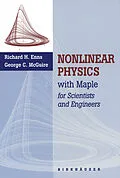Philosophy of the Text This text has been designed to be an introductory survey of the basic concepts and applied mathematical methods of nonlinear science. Students in engineer ing, physics, chemistry, mathematics, computing science, and biology should be able to successfully use this text. In an effort to provide the students with a cutting edge approach to one of the most dynamic, often subtle, complex, and still rapidly evolving, areas of modern research-nonlinear physics-we have made extensive use of the symbolic, numeric, and plotting capabilities of Maple V Release 4 applied to examples from these disciplines. No prior knowledge of Maple or computer programming is assumed, the reader being gently introduced to Maple as an auxiliary tool as the concepts of nonlinear science are developed. The diskette which accompanies the text gives a wide variety of illustrative nonlinear examples solved with Maple. An accompanying laboratory manual of experimental activities keyed to the text allows the student the option of "hands on" experience in exploring nonlinear phenomena in the REAL world. Although the experiments are easy to perform, they give rise to experimental and theoretical complexities which are not to be underestimated. The Level of the Text The essential prerequisites for the first eight chapters of this text would nor mally be one semester of ordinary differential equations and an intermediate course in classical mechanics.
Inhalt
1 Introduction.- 1.1 It's a Nonlinear World.- 1.2 Symbolic Computation.- 1.3 Nonlinear Activities.- 1.4 Structure of the Text.- 2 Some Nonlinear Systems.- 2.1 Nonlinear Mechanics.- 2.1.1 The Simple Pendulum.- 2.1.2 The Eardrum.- 2.1.3 Nonlinear Damping.- 2.1.4 Nonlinear Lattice Dynamics.- 2.2 Competition Phenomena.- 2.2.1 Volterra-Lotka Competition Equations.- 2.2.2 Population Dynamics of Fox Rabies in Europe.- 2.2.3 Eigen and Schuster's Theory of the Selection and Evolution of Biological Molecules.- 2.2.4 Laser Beam Competition Equations.- 2.2.5 Rapoport's Model for the Arms Race.- 2.3 Nonlinear Electrical Phenomena.- 2.3.1 Nonlinear Inductance.- 2.3.2 An Electronic Oscillator (the Van der Pol Equation).- 2.4 Chemical and Other Oscillators.- 2.4.1 Chemical Oscillators.- 2.4.2 The Beating Heart.- 2.5 Pattern Formation.- 2.5.1 Chemical Waves.- 2.5.2 Snowflakes and Other Fractal Structures.- 2.5.3 Rayleigh-Bénard Convection.- 2.5.4 Cellular Automata and the Game of Life.- 2.6 Solitons.- 2.6.1 Shallow Water Waves (KdV and Other Equations).- 2.6.2 Sine-Gordon Equation.- 2.6.3 Self-Induced Transparency.- 2.6.4 Optical Solitons.- 2.6.5 The Jovian Great Red Spot (GRS).- 2.6.6 The Davydov Soliton.- 2.7 Chaos and Maps.- 2.7.1 Forced Oscillators.- 2.7.2 Lorenz and Rössler Systems.- 2.7.3 Poincaré Sections and Maps.- 2.7.4 Examples of One- and Two-Dimensional Maps.- 3 Topological Analysis.- 3.1 Introductory Remarks.- 3.2 Types of Simple Singular Points.- 3.3 Classifying Simple Singular Points.- 3.3.1 Poincaré's Theorem for the Vortex (Centre).- 3.4 Examples of Phase Plane Analysis.- 3.4.1 The Simple Pendulum.- 3.4.2 The Laser Competition Equations.- 3.4.3 Example of a Higher Order Singularity.- 3.5 Isoclines.- 3.6 3-Dimensional Nonlinear Systems.- 4 Analytic Methods.- 4.1 Introductory Remarks.- 4.2 Some Exact Methods.- 4.2.1 Separation of Variables.- 4.2.2 The Bernoulli Equation.- 4.2.3 The Riccati Equation.- 4.2.4 Equations of the Structure (math).- 4.3 Some Approximate Methods.- 4.3.1 Maple Generated Taylor Series Solution.- 4.3.2 The Perturbation Approach: Poisson's Method.- 4.3.3 Lindstedt's Method.- 4.4 The Krylov-Bogoliubov (KB) Method.- 4.5 Ritz and Galerkin Methods.- 5 The Numerical Approach.- 5.1 Finite-Difference Approximations.- 5.2 Euler and Modified Euler Methods.- 5.2.1 Euler Method.- 5.2.2 The Modified Euler Method.- 5.3 Rungé-Kutta (RK) Methods.- 5.3.1 The Basic Approach.- 5.3.2 Examples of Common RK Algorithms.- 5.4 Adaptive Step Size.- 5.4.1 A Simple Example.- 5.4.2 The Step Doubling Approach.- 5.4.3 The RKF 45 Algorithm.- 5.5 Stiff Equations.- 5.6 Implicit and Semi-Implicit Schemes.- 6 Limit Cycles.- 6.1 Stability Aspects.- 6.2 Relaxation Oscillations.- 6.3 Bendixson's First Theorem: The Negative Criterion.- 6.3.1 Bendixson's Negative Criterion.- 6.3.2 Proof of Theorem.- 6.3.3 Applications.- 6.4 The Poincaré-Bendixson Theorem.- 6.4.1 Poincaré-Bendixson Theorem.- 6.4.2 Application of the Theorem.- 6.5 The Brusselator Model.- 6.5.1 Prigogine-LeFever (Brusselator) Model.- 6.5.2 Application of the Poincaré-Bendixson Theorem.- 6.6 3-Dimensional Limit Cycles.- 7 Forced Oscillators.- 7.1 Duffing's Equation.- 7.1.1 The Harmonic Solution.- 7.1.2 The Nonlinear Response Curves.- 7.2 The Jump Phenomenon and Hysteresis.- 7.3 Subharmonic and Other Periodic Oscillations.- 7.4 Power Spectrum.- 7.5 Chaotic Oscillations.- 7.6 Entrainment and Quasiperiodicity.- 7.6.1 Entrainment.- 7.6.2 Quasiperiodicity.- 7.7 The Rössler and Lorenz Systems.- 7.7.1 The Rössler Attractor.- 7.7.2 The Lorenz Attractor.- 8 Nonlinear Maps.- 8.1 Introductory Remarks.- 8.2 The Logistic Map.- 8.2.1 Introduction.- 8.2.2 Geometrical Representation.- 8.3 Fixed Points and Stability.- 8.4 The Period-Doubling Cascade to Chaos.- 8.5 Period Doubling in the Real World.- 8.6 The Lyapunov Exponent.- 8.7 Stretching and Folding.- 8.8 The Circle Map.- 8.9 Chaos versus Noise.- 8.10 2-Dimensional Maps.- 8.10.1 Introductory Remarks.- 8.10.2 Classification of Fixed Points.- 8.10.3 Examples.- 8.10.4 Nonconservative versus Conservative Maps.- 9 Nonlinear PDE Phenomena.- 9.1 Introductory Remarks.- 9.2 Burger's Equation.- 9.3 Bäcklund Transformations.- 9.3.1 The Basic Idea.- 9.3.2 Examples.- 9.3.3 Nonlinear Superposition.- 9.4 Solitary Waves.- 9.4.1 The Basic Approach.- 9.4.2 Phase Plane Analysis.- 9.4.3 KdV Equation.- 9.4.4 The Three-Wave Problem.- 10 Numerical Simulation.- 10.1 Finite Difference Approximations.- 10.2 Explicit Methods.- 10.2.1 Diffusion Equation.- 10.2.2 Fisher's Nonlinear Diffusion Equation.- 10.2.3 Klein-Gordon Equation.- 10.2.4 KdV Solitary Wave Collisions.- 10.3 Von Neumann Stability Analysis.- 10.3.1 Linear Diffusion Equation.- 10.3.2 Burger's Equation.- 10.4 Implicit Methods.- 10.5 Method of Characteristics.- 10.5.1 Colliding Laser Beams.- 10.5.2 General Equation.- 10.5.3 Sine-Gordon Equation.- 10.6 Higher Dimensions.- 11 Inverse Scattering Method.- 11.1 Lax's Formulation.- 11.2 Application to KdV Equation.- 11.2.1 Direct Problem.- 11.2.2 Time Evolution of the Scattering Data.- 11.2.3 The Inverse Problem.- 11.3 Multi-Soliton Solutions.- 11.4 General Input Shapes.- 11.5 The Zakharov-Shabat/AKNS Approach.
